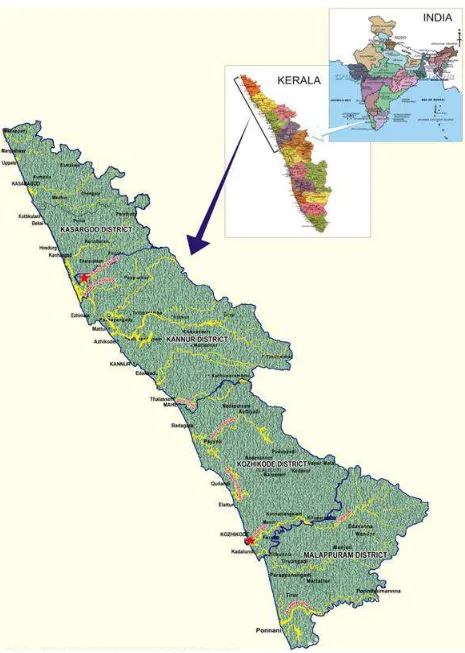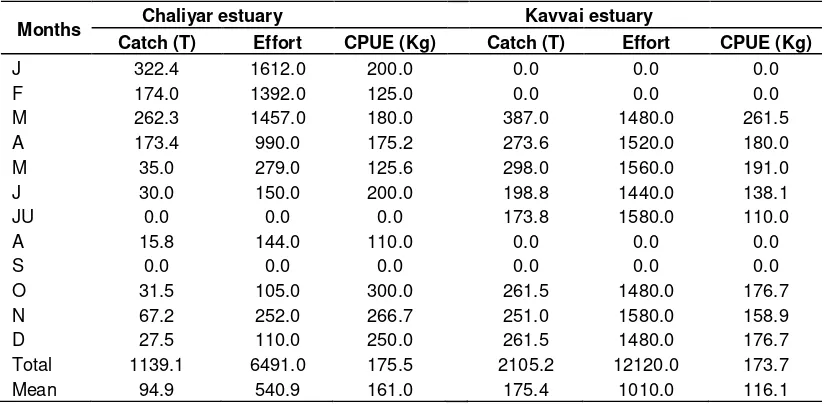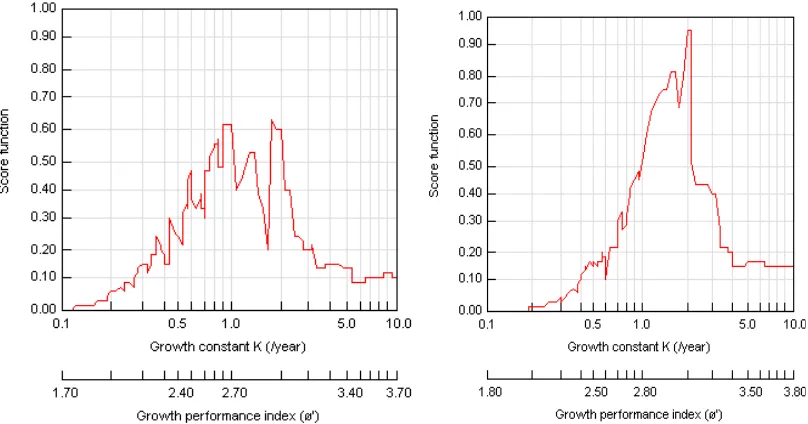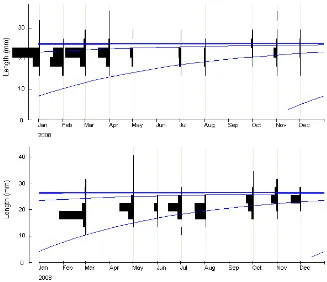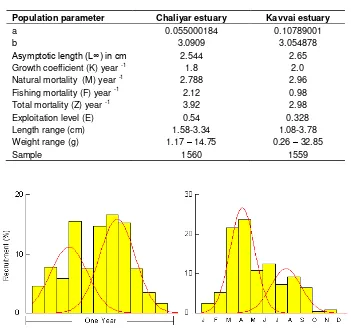DOI: 10.5897/IJFA12.035
ISSN 1991-637X©2013 Academic Journals http://www.academicjournals.org/IJFA
International Journal of Fisheries and
Aquaculture
Full length Research Paper
Population dynamics of the edible clam
Meretrix casta
(Chemnitz) (International Union for Conservation of
Nature status: Vulnerable) from two estuaries of North
Kerala, south west coast of India
P. Laxmilatha
Central Marine Fisheries Research Institute, P. B. NO. 1603., Ernakulam, Cochin 682 014, India.
Accepted 19 August 2013
The population parameters of the edible clam Meretrix casta (Chemnitz) from two estuaries along the coast of north Kerala, Southern India were estimated. M. casta has been cited as vulnerable as per al. (2006a). Growth of M. casta from the east coast has been reported by Abraham (1963), Durve (1970: 73) and Sreenivasan (1983). Jayawickrema and Wijeyratne (2009) have described the population dynamics of M. (IUCN) population status. The asymptotic length (L∞) for M. casta from Chaliyar estuary was 24.24 mm. The growth coefficient (K) was 1.8-1. The growth performance index (ф') was found to be 1.92 and t0 was calculated at -0.04283547 years. The length weight relationship is given by Log Y = -1.259635861 + 3.090977418Log X, r = 0.903010085. The total mortality (Z) estimate for M. casta from Chaliyar estuary was 3.92 year-1; fishing mortality (F) 2.12 year-1. Exploitation level (E) was 0.54. The asymptotic length (L∞) for M. casta from Kavvai estuary was 26.5 mm. The growth coefficient (K) was 2.0-1. The growth performance index (ф') was found to be 2.03 and t0 was calculated at -0.03441665 years. The length weight relationship is given by Log Y = -0.98701877 + 3.054878207 Log X, r = 0.613724895. The total mortality (Z) estimate for M. casta from Kavvai estuary was 2.98 year-1; fishing mortality (F) 0.98 year-1. Exploitation level (E) was 0.33. The M. casta is under exploited from both the estuaries. There is potential for increased exploitation of the edible clam from both estuaries since the present exploitation levels are far below the maximum sustainable yield (MSY).
Key words: Meretrix casta, population dynamics, Chaliyar, Kavvai estuaries, south west coast of India.
INTRODUCTION
Meretrix casta (Chemnitz) a venerid clam is edible and forms sustenance level fishery in the estuaries and backwaters of both east and west coast of India. Along west coast, it occurs in Goa, Aghnashini, Uppunda, Coondapur, Udyavara and Mulki estuaries in Karnataka and Ashtamudi, Chettuva, Beypore, Korapuzha, Moorad and Chaliyar estuaries in Kerala. This species contributes to livelihood of large number of fishers living along these estuaries (Laxmilatha et al., 2006a, b). Along the east
coast,itformsafisheryinVellar,Pulicatand Bhimunipatnam backwaters (Seshappa, 1971; Alagarswami and Meiyyapan,1989b;Narasimham, 1991).
Biology and growth of the white clam has been studied by Abraham (1963), Durve (1964), Seshappa (1971), Krishnakumari et al. (1977), Sreenivasan (1983), Thangavelu and Sanjeevraj (1985), Thangavelu and Poovannan (1994), and Rao (1988). Age and growth of
M. casta from west coast has been reported by Salih
254 Int. J. Fish. Aquac.
(1973), Parulekar et al. (1973) and Harkantra (1975). Fishery of M. casta has been described by Laxmilatha et al. (2006a). Growth of M. casta from the east coast has been reported by Abraham (1963), Durve (1970: 73) and Sreenivasan (1983). Jayawickrema and Wijeyratne (2009) have described the population dynamics of
M.casta in the Dutch canal of Sri Lanka. Influence of environmental variables on the abundance of M. casta in Southern Thailand has been detailed by Tanyaros and Tongnunui (2011).
M. casta has been cited as vulnerable (A 1c, 1d) by the International Union for Conservation of Nature (IUCN) based on the population decline in several estuaries due to decline in extent of occurrence area (bed), quality of habitat and number of mature individuals (Ananda-Rao et al., 1998). The knowledge of the population characteristics is important for the implementation of appropriate management and conservation measures for the sustainable exploitation of the stock. The objective of this study is to understand the population dynamics of M. casta from two geographically separate estuaries along the west coast of India, which will enable the development of conservation and management measures for sustaining the fishery.
MATERIALS AND METHODS
Monthly samples of the edible backwater clam M. casta (Chemnitz)
were collected from two estuaries Chaliyar (11°31’29°N -
76°3’26°E), in Kozhikode district, north Kerala and Kavvai estuary (11°21’-15°58’N - 75°47’-70°27’E) located in Kasargod district of north Kerala, south west coast of India during 2008 (Figure 1). A total of 1560 numbers.
M. casta and 1559 numbers were collected from Chaliyar and Kavvai respectively, for the study. The samples of M. casta were cleaned of all encrusting organisms. The total length was measured using digital vernier calipers to the nearest 0.1 mm along the anterior-posterior axis. The total weight was recorded in an electronic balance to the nearest 0.01 g. The monthly length frequency distribution data of M. casta were grouped into 3 mm intervals and used to estimate growth and population parameters using the FiSAT software (Gayanilo et al., 1995). Asymptotic length (L∞) and growth coefficient (K) of the von Bertalanffy growth
function (VBGF) were estimated by means of ELEFAN –1 (Bertalanffy, 1934; Pauly, 1986). K-scan routine was conducted to assess a reliable estimate of the K value. The estimates of L∞ and K
were used to estimate the growth performance index (Φ’) (Pauly
and Munro, 1984) of M. castausing the equation Φ’= 2 log10 L∞ + log 10 K.
The length – weight relationship (W = a Lb) was studied following Ricker (1975), where W is the weight (g), L the total length (mm), a
the intercept (condition factor) and b is the slope (growth coefficient / relative growth rate). The parameters a and b were estimated by least squares linear regression on log-log transformed data: log 10
W = log 10 a + b log 10 L. The coefficient of determination (r2) was used as an indicator of the quality of the linear regression. The inverse von Bertalanffy growth equation (Sparre and Venema, 1992) was used to find lengths of the M. casta at various ages. The VBGF was fitted to estimates of the length at curve using non-linear estimation procedure the VBGF is defined by the equation:
Lt = L∞ [1-e -k (t – t0)]
Where Lt is the mean length at age L∞ the asymptotic length, K the
growth coefficient, t the age of the M. casta and t0 is the
hypothetical age at which the length is zero.
The total mortality (Z) was estimated by the length converted
respectively, where “Y” is the annual average catch of the species (Beverton and Holt, 1957; Ricker, 1975). Maximum sustainable yield (MSY) was calculated by the equation for exploited stocks, MSY = Z*0.5*B (Gulland, 1979). The recruitment pattern of the stock was determined by the backward projection on the length axis of the set of available length frequency data as in FiSAT.
RESULTS
Fishery
256 Int. J. Fish. Aquac.
Table 1. Fishery details of M. casta in two estuaries 2008.
Months Chaliyar estuary Kavvai estuary
The size range of M. casta contributing to the fishery in Kavvai estuary was 11.2 to 37.8 mm. The modal classes were 18-20 (28%), 20-22 (25.4%) and 16-18 (14.6%). 0.98701877 + 3.054878207 Log X, r = 0.613724895. The computed growth coefficient (b) was 3.05.
Chaliyar estuary. The growth performance index (ф’) was
found to be 1.91606 and t0 was calculated at
M. casta from Chaliyar estuary was estimated as 2.5 to 3 years (Figures 2 and 3).
Kavvai estuary
Asymptotic length (L∞) of the VBGF was 26.5 mm and the
growth coefficient (K) was 2.0-1 for M. casta from Kavvai
estuary. The growth performance index (ф’) was found to
be 2.025305865 and t0 was calculated at _0.03441665 restructured length distribution using the growth parameters are shown in Figures 4 and 5.
Figure 2. Estimation of Lα and Z/K of Meretrix casta (Chaliyar and Kavvai estuary) using Powell- Wetherall plot.
Figure 3. Estimation of K of M. casta and (Chaliyar estuary andKavvai estuary).
M. casta (Table 2).Exploitation level (E) of M. casta was 0.54 (Table 2).
Kavvai estuary
The total mortality (Z) estimates for M. casta from Kavvai estuary was 2.98 year -1. Natural mortality (M) was 2.96 year -1 and fishing mortality (F) 0.98 year -1 for M. casta
(Table 2). Exploitation level (E) of M. casta was 0.33
(Table 2).
Recruitment pattern
Chaliyar estuary
The recruitment pattern of M. casta was continuous throughout the year, however, two major peaks of recruitmentwasobservedduringAprilandJuneto August
α α
REGRESSION EQUATION
Chaliyar estuary Kavvai estuary
258 Int. J. Fish. Aquac.
Figure 4. Plot of age and growth of M. casta (Chaliyar and Kavvai estuary) based on computed growth parameters.
Figure 5. Restructured length frequency distribution with growth curves superimposed using ELEFAN I (Lα = 25.44 mm, K = 1.8 year -1) M. casta (Chaliyari estuary) (Lα =
29.51 mm, K = 2 year -1) M. casta (Kavvai estuary).
(Figure 6). The peak pulses produced over 70% of the observed recruitment during the year.
Kavvai estuary
The recruitment pattern of M. casta was continuous t hroughout the year, however, two major peaks of recruitment were observed during March-April and June
to August (Figure 6). The peak pulses produced over 70% of the observed recruitment during the year.
Estimation of stock and MSY
Chaliyar estuary
The annual total stock (2008) of M. casta was estimated
0 5 10 15 20 25 30
1 4 7 10 13 16 19 22 25 28 31 34 37 40 43 46 49 52 55 58
Age (months)
L
e
n
g
th
(
m
m
)
0 5 10 15 20 25 30
1 4 7 10 13 16 19 22 25 28 31 34 37 40 43 46 49 52 55 58
Age (months)
L
e
n
g
th
(
m
m
Table 2. Population parameters of Meretrix casta, from two different estuaries, south west coast of India.
Population parameter Chaliyar estuary Kavvai estuary
a 0.055000184 0.10789001
b 3.0909 3.054878
Asymptotic length (L∞) in cm 2.544 2.65
Growth coefficient (K) year -1 1.8 2.0
Natural mortality (M) year -1 2.788 2.96
Fishing mortality (F) year -1 2.12 0.98
Total mortality (Z) year -1 3.92 2.98
Exploitation level (E) 0.54 0.328
Length range (cm) 1.58-3.34 1.08-3.78
Weight range (g) 1.17 – 14.75 0.26 – 32.85
Sample 1560 1559
Figure 6. Recruitment pattern of M. casta (Chaliyar and Kavvai estuary).
at 0.0004654 t. The biomass (standing stock) was estimated at 537.3 t and maximum sustainable yield (MSY) of M. casta was estimated at 1053.13 t. The exploitation rate (U) was 0.53.
Kavvai estuary
The annual total stock of M casta (2008) was estimated at 0.0001483 t. The biomass (standing stock) was estimated at 2148.2 t and maximum sustainable yield (MSY) of M. casta was estimated at 3200.8 t. The exploitation rate (U) was 0.31.
DISCUSSION
M. casta forms a significant sustenance - level fishery in all major estuaries of India (Narasimham, 1991). M. casta
is euryhaline, can tolerate low salinities and prefers high sand and silt habitat (NarasimhamandLaxmilatha,1991). The fishery of the edible clam is dependent on the spat fall and subsequent recruitment of the fishery. Salinity,
temperature sediment texture and organic matter contribute to the abundance of bivalves (Lee, 1972). The spat fall is affected by the benthic state and pollution by increased pH due to coconut fibre retting and alteration of the sand bed due to sand mining. This has been reported for M. casta in Moorad estuary and Chettuva estuaries which has affected spat fall of M. casta from year to year (Laxmilatha et al., 2006a, b). The abundance of M. casta
is also positively correlated to the organic matter content in the substrate (Fraga and Vives, 1960; Jayawardene and Wijayaratne, 2009). The salinity and total suspended solids (TSS) were critical factors influencing the abundance of estuarine clams. The pH and iron concentrations in bottom sediment water strongly related to clam densities (Jayawickrema and Wijeyaratne, 2009; Tanyaros and Tongnunui, 2011).
260 Int. J. Fish. Aquac.
in 9 months (Salih, 1973) and 35.4 mm in 11 months in Cochin barmouth, west coast (Salih, 1973). Durve (1970) reported slower growth rate of 0.79 mm per month in the fish farm in Mandapam due to high saline conditions. Sreenivasan (1983) reported growth of 34 in 13 months in M. casta transplanted to Vellar estuary. Balasubramaniam and Natarajan (1987) reported of 23 mm in the first year, 38.3 mm in the second year and 50.6 mm in the third year for M. casta in Vellar estuary. These variations in growth are due to the variations in hydrological conditionsin theestuaries (Balasubramanian and Natarajan, 1987; Jayabal and Kalyani, 1986; Sreenivasan, 1983). The mean weight of clams fished from Kavvai estuary were higher (4.7 g) than those fished from Chaliyar estuary. This implies that the hydrographical conditions and productivity of the two estuaries have an important bearing on the growth of the clams (Abraham, 1963; Seshappa, 1971). The condition indexes of the clams from both the estuaries were almost same.
M. casta from Adyar backwater has been reported to attain a size of over 56.5 mm in a period of three years. However, since over 95% of the clams are fished before they reach a length of 30 mm (Abraham, 1963). In Korapuzha and Beypore estuaries on the west coast maximum size of 31 mm was obtained during 1950-1951) (Sheshappa, 1971). In Bhimunipatnam estuary on the east coast also, M. casta of over 20 mm formed only 5% of the fished clams clams over 40 mm were rarely rare (Ramamohana-Rao et al., 1977). Similar is the case in Chaliyar and Kavvai estuaries, clams of over 40 mm were rarely seen. The growth parameters reported for M. casta
from five different sites in the Dutch canal of Sri Lanka ranges from 34 to 43.1 mm and growth coefficient ranged from 0.84-1 to 1.44-1 (Jayawickrema and Wijeyaratne, 2009). The growth attained by M. casta in both estuaries was also same and life span estimated was also 3 years in both cases. The computed growth co efficient (b) of M. casta from both water bodies are nearly same and growth was isometric. Isometric growth has been reported in M. casta (Narasimham et al., 1988). especially during early stages, the abbreviated larval stages, early attainment of sexual maturity, discontinuous breeding throughout the year with at least two peaks and euryhaline tolerance to salinity (Abraham, 1963; Balasubramanian and Natarajan, 1987; Jayawickrema and Wijeyaratne, 2009; Tanyaros and Tongnunui, 2011).
The total mortality (Z) estimate of M. casta from Chaliyar was higher compared to that of Kavvai estuary, fishing mortality was higher for M. casta from Chaliyar compared to Kavvai The exploitation level of M. casta in Chaliyar was 0.54 while it was very low in Kavvai at 0.33. The standing stock of M. casta in Chaliyar estuary is much lower compared to that in Kavvai estuary.
However, the clam fishery has sustained the livelihood of the local pickers for a long period of time and in recent years spat fall has become highly variable due to the changes in the bed due to environmental changes and climatic factors. It is reported that post Tsunami of 2004, there was very poor spatfall of M. casta in the Chaliyar estuary and consequently very poor recruitment in the following year. Heavy mortality due to heavy flooding in the west coast and poor yield of clam in the Mumbai coast due to excessive rainfall has been reported by Hornell (1916) and Rai (1932). In Kavvai estuary, several species of clams contribute to the fishery along with fishes. Meretrix meretrix, Paphia malabarica and Villorita cyprinoides are landed in significant quantities apart from
M. casta and have higher market demand than M. casta. Therefore, a huge stock of M. casta is present which can still continue to sustain the fishery. The present level of exploitation of M. casta is far below the MSY and therefore production of M. casta can be significantly enhanced on a sustainable level. In Chaliyar, the present exploitation is only 50% of the MSY.
The population characteristics of M. casta from the two estuaries indicate that the two stocks can still be exploited on a sustainable level. However, the major issue of concern is the changes in the habitat / sand bed of the clams. Large scale sand mining also affects the spat settlement due to high levels of total suspended solids (Laxmilatha et al., 2006a, b). M. casta is fished for the meat (for local consumption) and shell in most estuaries. The undersized clams are exploited during the peak season, the meat is allowed to putrefy and shells are used by the lime industry (Laxmilatha et al., 2006a, b). Conservation measures such as relaying, ranching of seed for stock enhancement, regulations to restrict exploitation of seed clams, measures to regulate sand mining are imperative to manage the stocks of M. casta, which is gradually on its way to the endangered status
The authors thank the Director, Central Marine Fisheries Research Institute, Cochin for support and encouragement in carrying out this work.
REFERENCES
Abraham KC (1963). Observations on the biology of Meretrix casta (Chemnitz). J. Zool. Soc. India 5(2):163-190.
Alagarswami K, Meiyyappan MM (1989b). Prospects and problems of management and development of marine molluscan resources (other than cephalopods) in India. Bull. Cent. Mar. Fish. Res. Inst. 44(1):250-261.
mangroves of India’ Zoo outreach organization, Coimbatore, India, P. 106.
Balasubramanian K, Natarajan R (1987). Age and growth of Meretrix
casta(chemnitz) in Vellar estuary, Parangipettai Bull. Cent. Mar.
Fish. Res. Inst. 42(1):145-147.
Bertalanffy L von (1934). Untersuchungen uber die Gesetzlichkeiten des Wachstums1. llgemeine Grundlagen der Theorie. Roux Arch. Entwicklungsmech. Org. 131:613-653.
Beverton RJH, Holt SJ (1957). On the dynamics of exploited fish populations. Fish. Invest. Ser. II London 19:533.
Durve VS (1964). Preliminary observations on the seasonal gonadal changes and spawning in the clam Meretrix casta (Chemmitz) from the marine fish farm. J. Mar. Biol. Assoc. India 6(2):241-248: Durve VS (1970). On the growth of the clam Meretrix casta (Chemnitz)
from the Marine Fish Farm. J. Mar. Biol. Assoc. India. 12:125-135 Fraga F, Vives F (1960). Retention of particulate matter, In: Marine
mussels: Their Ecology, and Physiology (B. L. Bayne ed.). pp.13-65, Cambridge University Press, UK.
Gayanilo FC, Jr Sparre P, Pauly D (Eds.) (1995). The FAO- ICLARM Stock Assessment Tools (FiSAT) User’s Manual. FAO Computerized
Information Series (Fisheries) No. 8: Rome, FAO. P. 185.
Gayanilo FC, Jr Sparre P, Pauly D (1997). The FAO- ICLARM Stock Assessment Tools (FiSAT) User’s Manual. Reference Manual, FAO, Rome, Italy, P. 126. the Madras Presidency. Madras Fish. Department Bull. 8:105-126. Jayabal R, Kalyani M (1986). Age and growth of the estuarine clam
Meretrix meretrix (L) inhabiting the Vellar stuary. Mahasagar
19(2):141-146.
Jayawickrema EM, Wijeyaratne MJS (2009). Distribution and population dynamics of the edible bivalve species Meretrix casta (Chemnitz) in the Dutch canal of Sri Lanka. Sri Lanka. J. Aquatic Sci. 14:29-44. Krishnakumari L, Rajagopal MD, Sumitra V (1977). Some aspects of
biology and biochemistry of the backwater clam Meretrix casta (Chemnitz). Mahasagar Bull. Nat. Inst. Oceangr. 10(3/4):157-163 Laxmilatha P, Velayudhan TS, Mohamed KS, Kripa V, Radhakrishnan estuary. KeralaIndian J. Fish. 53(4):481-486,
Lee C (1972). An ecological study on some marine bivalve beds of Korean tide lands. In: proceedings of the Indo-pacific Fisheries Council 13th Sessions, Brisbane, Australia. pp.326– 331,
Narasimham K, Muthiah AP, Sundararajan D, Vaithinathan N (1988). Biology of the great clam Meretrix meretrix in the Korampallam creek, Tuticorin. Indian J. Fish. 35(4):288-293.
Pauly D (1980). On the interrelationships between natural mortality, growth parameters and mean environmental temperature in 175 fish stocks. ICES. J. Cons. 39:175-192.
Pauly D (1984). Length converted catch curves: A powerful tool for fisheries research in the tropics (Part II). Fishbyte 2(1):17-19. Pauly D (1986). On improving operation and use of the ELEFAN Bhimunipatnam backwaters. Indian J. Fish. 24 (1,2):263-268. Rao GS (1988). Biology of Meretrix casta (Chemnitz) and Paphia
malabarica (Chemnitz) from Mulky estuary, Dakshina Karnataka. In:
S. Mahadevan, KA, Narasimham, K. Satyanarayana Rao, KMS, Ameer Hamsa P Muthiah (Eds.), National seminar on shell fish resources and farming– Tuticorin. 19-21 January 1987. Bull. Cent. Mar. Fish. Res. Inst. 42(1):148-153
Ricker WE (1975). Computation and interpretation of biological statistics of fish populations. Bull. Fish. Res. Bd. Canada 191:382
Seshappa G (1971). Some observations on the backwater clam
Meretrix casta (Chemnitz) in the Beypore and Korapuzha estuaries.
Indian J. Fish. 14 (1&2):298-305
Salih MKY (1973). On the growth of the backwater clam Meretrix casta (Chemnitz) in the clam beds off Cochin barmouth. J. Mar. Biol. Ass. India 15(1):345-353.
Sparre P, Venema SC (1992). Introduction to tropical fish stock assessment, Part I, annual. FAO Fish. Technical. 306:376.
Sreenivasan PV (1983), Growth of the clam Meretrix casta (Chemnitz) transplanted in the Vellar estuary. Proc. Symp. Coastal Aquac. 2:564-568
Tanyaros S, Tongnunui P (2011).Influence of environmental variables o the abundance of estuarine clam Meretrix casta (Chemnitz, 1782) in Trang Province, Southern Thailand. Songklanakarin J. Sci. Technol. 33(1):107-115.
Thangavelu R, Poovannan P (1994). Some aspects of biology of the clam Meretrix casta (Chemnitz) in Muttukadu backwaters. J. Mar. Biol. Assoc. India. 36(1&2):77-80.
Thangavelu R, Sanjeevraj PJ (1985). Fishery and biology of the clam
Meretrix casta (Chemnitz) in Pulicat Lake. J. Mar. Biol. Assoc. India,
